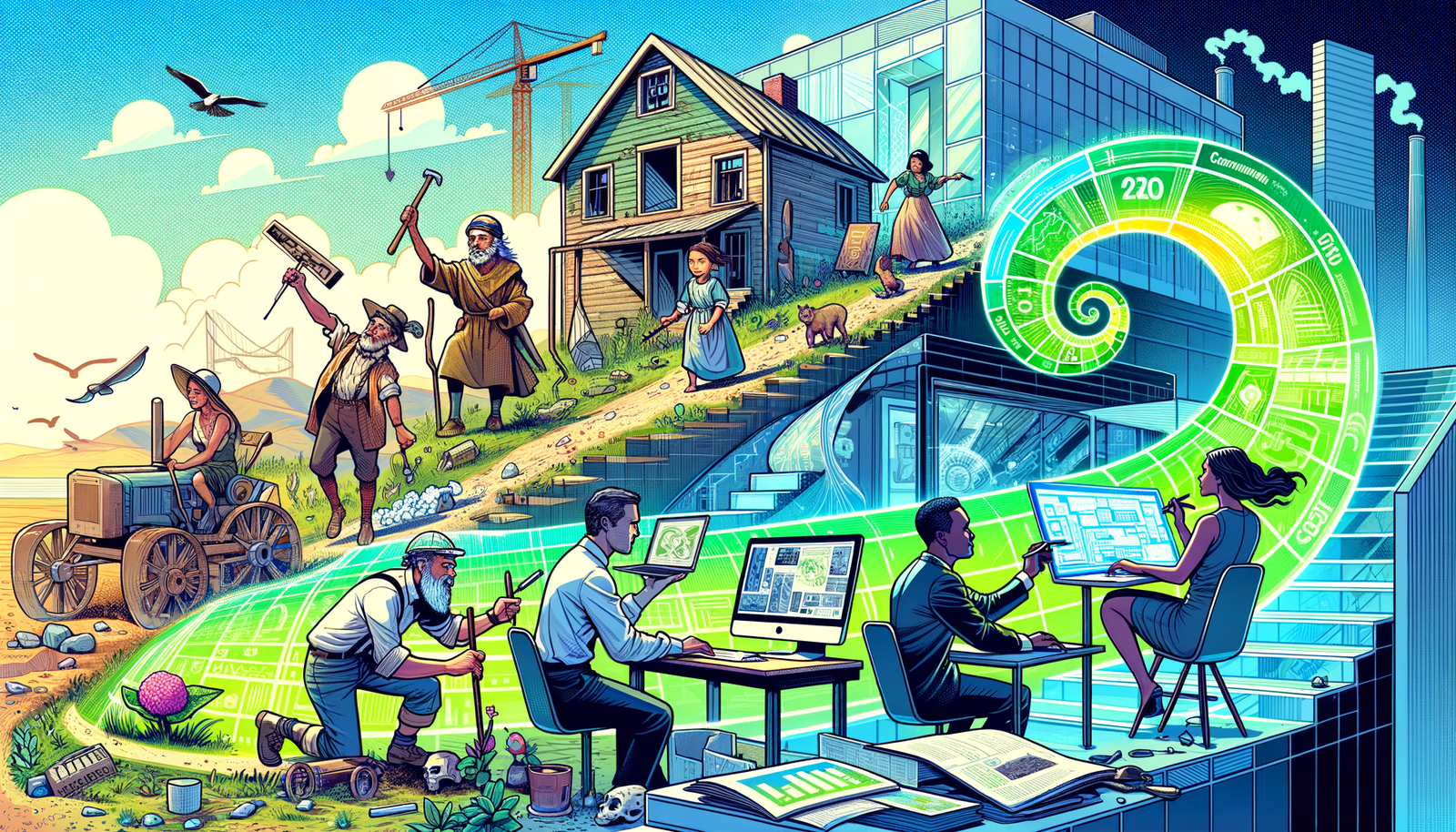Your Cart is Empty
Customer Testimonials
-
"Great customer service. The folks at Novedge were super helpful in navigating a somewhat complicated order including software upgrades and serial numbers in various stages of inactivity. They were friendly and helpful throughout the process.."
Ruben Ruckmark
"Quick & very helpful. We have been using Novedge for years and are very happy with their quick service when we need to make a purchase and excellent support resolving any issues."
Will Woodson
"Scott is the best. He reminds me about subscriptions dates, guides me in the correct direction for updates. He always responds promptly to me. He is literally the reason I continue to work with Novedge and will do so in the future."
Edward Mchugh
"Calvin Lok is “the man”. After my purchase of Sketchup 2021, he called me and provided step-by-step instructions to ease me through difficulties I was having with the setup of my new software."
Mike Borzage
Design Software History: The Evolution of Sustainable Architecture: Pioneers, Software Innovations, and Future Trends in Design Technology
March 25, 2025 8 min read


Early Concepts of Sustainability in Architecture
The dawn of sustainable architecture can be traced back to the early 20th century when architects began to recognize the importance of integrating environmental considerations into building design. This period marked a significant shift from purely aesthetic and functional concerns to a more holistic approach that included the natural surroundings and resource efficiency. Pioneers like Frank Lloyd Wright emphasized harmony between human habitation and the natural world, advocating for structures that were in sync with their environment. This early adoption of eco-conscious design principles laid the groundwork for what would eventually evolve into modern sustainable architecture.
As industrialization progressed, the environmental impact of construction became increasingly apparent. The depletion of natural resources and the rise in pollution highlighted the need for more responsible building practices. Architects and theorists began to explore concepts like passive solar design, natural ventilation, and the use of local materials to reduce the ecological footprint of structures. These initial concepts were fundamental in shaping the philosophies that would drive the development of specialized design tools focused on sustainability.
Pioneers of Sustainable Design and Their Influence on Software Development
The evolution of sustainable architecture was significantly influenced by key figures and organizations dedicated to promoting environmental stewardship in design. Architect R. Buckminster Fuller was a visionary whose work on geodesic domes exemplified efficient use of materials and energy, embodying the principle of doing more with less. His ideas inspired a generation of architects to consider sustainability as a central design criterion. Similarly, Ian McHarg's seminal work, "Design with Nature," published in 1969, introduced methods for analyzing environmental data to inform planning decisions. McHarg's emphasis on ecological planning had a profound impact on the integration of environmental considerations into architectural practice.
Organizations such as the American Institute of Architects (AIA) began to incorporate sustainability into their codes and standards, reflecting a growing institutional commitment to environmental issues. The formation of the U.S. Green Building Council (USGBC) in 1993 and the subsequent development of the Leadership in Energy and Environmental Design (LEED) certification system provided formal frameworks for evaluating and promoting sustainable design. These developments created a demand for software tools that could help architects meet new sustainability benchmarks, directly influencing the trajectory of design software development.
Early Software Tools for Sustainable Architecture
The initial generation of software tools for sustainable architecture emerged in response to the need for quantifiable analysis of environmental performance. In the 1970s, the Department of Energy developed DOE-2, one of the first computer programs capable of simulating building energy consumption. Although powerful for its time, DOE-2 was complex and required significant expertise to operate, limiting its accessibility for many architects. Despite these limitations, it represented a significant innovation by enabling the analysis of energy efficiency in building designs.
In the 1990s, software like Ecotect, developed by Andrew Marsh, began to bridge the gap between complex simulation tools and the architectural design process. Ecotect provided a more user-friendly interface and integrated environmental analysis with 3D modeling, allowing architects to visualize and assess the impact of design decisions on factors like solar exposure, daylighting, and thermal performance. These early tools, while innovative, often faced challenges such as limited computational power and compatibility issues with other design software, highlighting the need for more advanced and integrated solutions.
The Role of Data Advancements in Sustainable Architecture Tools
The integration of environmental data into design software marked a pivotal advancement in sustainable architecture. As data collection methods improved, architects gained access to detailed information about climate patterns, topography, and other environmental factors critical to sustainable design. This shift was facilitated by the advent of Geographic Information Systems (GIS), which provided powerful tools for mapping and analyzing spatial data. GIS technology enabled architects to consider site-specific environmental conditions in greater detail, leading to more informed and sustainable design decisions.
Advancements in data processing also enhanced the capabilities of energy modeling software. Tools like EnergyPlus, developed by the U.S. Department of Energy, allowed for sophisticated simulations of building energy performance, incorporating variables such as weather data, occupancy patterns, and mechanical systems. These tools provided architects with the ability to predict how design choices would impact energy consumption, facilitating optimization for sustainability. The inclusion of environmental performance metrics within design software empowered architects to make data-driven decisions throughout the design process.
Enhancing Design Software with GIS and Energy Modeling
The incorporation of GIS and energy modeling into design software significantly expanded the potential for sustainable architecture. GIS allowed architects to analyze and visualize environmental data in relation to geographic location, such as solar radiation levels, prevailing winds, and natural vegetation. This integration supported the creation of designs that were better adapted to their specific environmental contexts. Energy modeling software enabled the simulation of building performance under various scenarios, providing insights into potential energy savings and emissions reductions.
- GIS integration facilitated site-specific environmental analysis.
- Energy modeling enabled predictive assessments of building performance.
- Data-driven design improved the accuracy of sustainability evaluations.
Software platforms began to offer integrated solutions that combined modeling, analysis, and visualization tools. Programs like Autodesk's Revit incorporated energy analysis capabilities, allowing architects to assess energy performance within the primary design environment. This seamless integration reduced the barriers to conducting environmental analyses and promoted the adoption of sustainable practices within the architectural profession.
Parametric and Generative Design Methodologies in Sustainability
The emergence of parametric and generative design methodologies represented a significant leap forward in sustainable architecture. Parametric design introduced the concept of using algorithms to define relationships between design elements, enabling the systematic exploration of design variations. This approach allowed architects to optimize building performance by adjusting parameters and immediately seeing the effects on the overall design. Generative design extended this concept by using computational algorithms to generate design solutions based on predefined goals and constraints.
These methodologies were facilitated by advancements in computational power and the development of software tools such as Grasshopper for Rhinoceros 3D and Dynamo for Revit. Architects could now create complex geometries and perform sophisticated analyses that were previously impractical. The ability to rapidly iterate and optimize designs for factors like energy efficiency, daylight utilization, and material usage significantly enhanced the potential for sustainability in architectural projects.
Software Advancements Enabling Optimization for Sustainability
The development of specialized software tools was critical in enabling architects to apply parametric and generative methodologies to sustainable design. Tools like Autodesk's Generative Design provided platforms for setting performance criteria and automatically generating design options that met those objectives. These advancements allowed architects to explore a wide range of design possibilities efficiently, focusing on solutions that optimized environmental performance.
The integration of simulation and optimization algorithms into design software made it possible to balance multiple sustainability factors simultaneously. Architects could consider trade-offs between competing objectives, such as maximizing natural light while minimizing heat gain. This holistic approach to design was made practical by the ability of software tools to handle complex calculations and present results in an accessible format. The widespread adoption of these tools has led to significant improvements in the sustainability of architectural projects globally.
- Parametric tools enabled systematic exploration of design variations.
- Generative design facilitated optimization based on sustainability goals.
- Advanced software allowed for simultaneous consideration of multiple factors.
Current Cutting-Edge Design Tools for Sustainable Architecture
The contemporary landscape of sustainable architecture is characterized by a diverse array of advanced design tools that offer unprecedented capabilities. Software like Autodesk Insight provides integrated energy and environmental performance analysis within the design workflow, allowing architects to evaluate building performance in real-time. Features include daylight analysis, solar radiation studies, and energy cost estimates, all within a user-friendly interface. Similarly, tools like IES VE offer comprehensive building performance simulation, covering aspects such as thermal comfort, airflow, and renewable energy potential.
Building Information Modeling (BIM) platforms have become central to sustainable design, offering collaborative environments where multidisciplinary teams can work together seamlessly. BIM software facilitates the coordination of architectural, structural, and MEP (mechanical, electrical, and plumbing) systems, ensuring that sustainability considerations are integrated throughout the project lifecycle. The capability to simulate and analyze building performance from the early design stages enhances the potential for achieving sustainability targets and complying with regulatory requirements.
The Influence of Artificial Intelligence and Machine Learning
Artificial intelligence (AI) and machine learning are increasingly influencing the development of design software, providing new tools for advancing sustainability in architecture. AI algorithms can process vast amounts of data to identify patterns and optimize design solutions beyond traditional human capabilities. Machine learning models can predict building performance based on historical data, allowing for more accurate simulations and informed decision-making.
Software applications are incorporating AI to automate repetitive tasks and generate design options that meet specific sustainability criteria. For instance, Spacemaker, an AI-powered tool, helps architects optimize urban site development by analyzing factors such as sunlight exposure, wind conditions, and noise levels. By leveraging AI, architects can explore a broader range of design strategies in less time, enhancing the potential for innovative and sustainable solutions.
Future Trends and Anticipated Developments
The future of sustainable architecture design software is poised for significant advancements driven by emerging technologies. One anticipated trend is the increased integration of virtual and augmented reality (VR/AR) into the design process. VR/AR tools will allow architects and clients to experience designs in immersive environments, enhancing the understanding of spatial relationships and environmental impacts. This technology has the potential to improve collaboration and facilitate more effective communication of sustainability concepts.
Another key development is the growing use of cloud-based platforms and big data analytics. Cloud computing will enable more complex simulations and real-time collaboration among geographically dispersed teams. The ability to analyze large datasets will improve the accuracy of environmental performance predictions and support more sophisticated optimization algorithms. Additionally, advancements in material science may lead to the development of new sustainable materials, necessitating the creation of software tools capable of modeling their properties and behaviors accurately.
The integration of the Internet of Things (IoT) with building design software is also expected to play a significant role. IoT devices can provide real-time data on building performance, occupant behavior, and environmental conditions. This data can inform adaptive design strategies and facilitate the creation of buildings that respond dynamically to changing conditions, enhancing sustainability throughout the building's operational life.
Conclusion
The evolution of sustainable architecture design tools reflects a dynamic interplay between technological innovation and environmental stewardship. From the initial concepts of integrating nature into design to the sophisticated software solutions available today, there has been a clear trajectory toward enhancing architects' ability to create sustainable structures. The incorporation of environmental data, the advent of parametric and generative design methodologies, and the influence of AI and machine learning represent significant milestones in this journey.
These developments have had a profound impact on promoting sustainability within the architectural field. Design tools have become integral in enabling architects to quantify and optimize environmental performance, leading to buildings that are more energy-efficient, resource-conscious, and responsive to their surroundings. The ability to model, simulate, and analyze various aspects of building performance has transformed sustainable architecture from a niche concern to a fundamental component of modern design practice.
Looking forward, the potential for innovation in design software is vast. Emerging technologies promise to further enhance capabilities, offering new ways to address the complex challenges of sustainability. As architects continue to adopt and develop these tools, the built environment will increasingly reflect a commitment to environmental responsibility, contributing to a more sustainable future for all.
Also in Design News

Cinema 4D Tip: Filmic OCIO Pipeline and Camera-Based Exposure
November 05, 2025 2 min read
Read More
Bluebeam Tip: Track accountability with the Owner field in Bluebeam Revu
November 05, 2025 2 min read
Read More
ZBrush Tip: IMM workflow for distortion‑free inserts and fast curve placement
November 05, 2025 2 min read
Read MoreSubscribe
Sign up to get the latest on sales, new releases and more …


